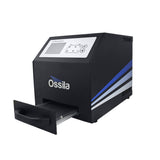What is UV Sterilization?

Ultraviolet (UV) sterilization is a disinfecting technique, carried out using equipment such as a laminar flow hood, that uses UV light to kill or damage microorganisms, such as bacteria, viruses, and fungi.
UV light is an electromagnetic radiation with a wavelength shorter than visible light, but longer than X-ray radiation. The UV light spectrum is split into different types, including UVA, UVB, and UVC. These types vary in wavelength, penetration capabilities, and effects on living organisms.
Types of UV Light
Primarily, UVA contributes to premature ageing, whereas UVB is responsible for causing sunburn. Exposure to these types of UV light is also linked to the increased risk of skin cancer. On the other hand, UVC is used for disinfecting purposes and is not typically a concern for skin exposure as natural UVC is absorbed by the Earth's atmosphere. UVC is extremely effective at killing microorganisms, making it a valuable tool for disinfection and sterilization. UV sterilization has a wide variety of applications including:
-
Water treatment to disinfect drinking water.
-
Surface sterilization to disinfect laboratory benches and high-contact surfaces in healthcare settings.
-
Medical sterilization to disinfect medical equipment, patient rooms or personal protective equipment (PPE).
UV Light and Microorganisms
UVC light sterilizes surfaces by killing or inactivating microorganisms. The mechanism involves disrupting the genetic material of the microorganism.
To begin, the UVC light photons emitted are absorbed by the microorganism. This triggers chemical reactions within the microorganism. Covalent bonds form between adjacent thymine-thymine molecules in DNA, and uracil-uracil molecules in RNA. The formation of these covalent bonds creates structural abnormalities in the DNA or RNA strands. Consequently, genetic replication and function is disrupted. With damaged DNA or RNA, microorganisms are unable to accurately replicate or successfully reproduce. This results in death or inactivation of the microorganism.
UV Sterilization in Laminar Flow Hoods
UV sterilization is commonly used in laminar flow hoods to maintain a sterile environment for various laboratory methods. Laminar flow hoods are designed to provide a contaminant-free environment using filtered air flow to protect sensitive materials, experiments, and samples.
Within a laminar flow hood, UV sterilization is an added layer of protection against contamination. Lamps emitting UVC light, in the range of 200 to 280 nanometers, are integrated into the hood. This feature is activated when the hood is not in use to sterilize and clean the hood before or after an experiment. The inclusion of UV light in our laminar flow hood ensures the cleanliness of your workspace is maintained.
Dangers of UV Light
It is important to follow safety precautions when using artificial UVC light as it can be harmful to both the skin and eyes. When the UV light in a laminar flow hood is activated, you should not be present. Necessary PPE should be worn, such as UV-blocking safety glasses and gloves, when handling UVC lamps. The Ossila laminar flow hoods are equipped with a UV safety feature which switches off the light when motion is detected.
Laminar Flow Hood

Learn More
 UV Ozone Cleaning: Theory and Application
UV Ozone Cleaning: Theory and Application
UV ozone cleaning relies upon the use of a high-intensity UV light source, which illuminates the surface to be cleaned with two specific wavelengths of light. Low pressure mercury vapor discharge lamps are typically used, like the synthetic quartz UV grid lamp in the Ossila UV Ozone Cleaner, which have two dominant emission peaks at 184 nm and 254 nm.
Read more... What are Sterile Techniques?
What are Sterile Techniques?
In any laboratory setting, maintaining a sterile environment is essential for the success of experiments. Especially when you are working with cultures, tissues, or microbial samples. The primary goal of sterilization is to get rid of all microorganisms from surfaces and materials. This helps with reducing the risk of contamination and ensuring accurate results.
Read more...References
- Boardman, E.A. et al. (2012) ‘Deep ultraviolet (UVC) laser for sterilization and fluorescence applications’, Sharp Tech. Rep.